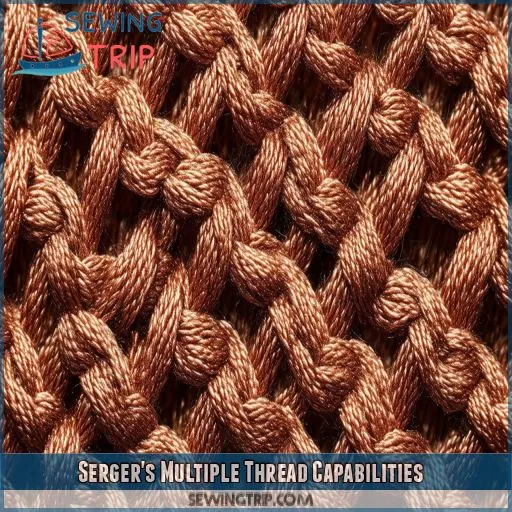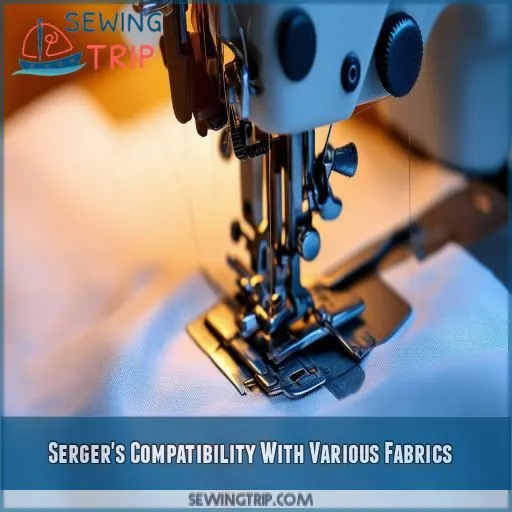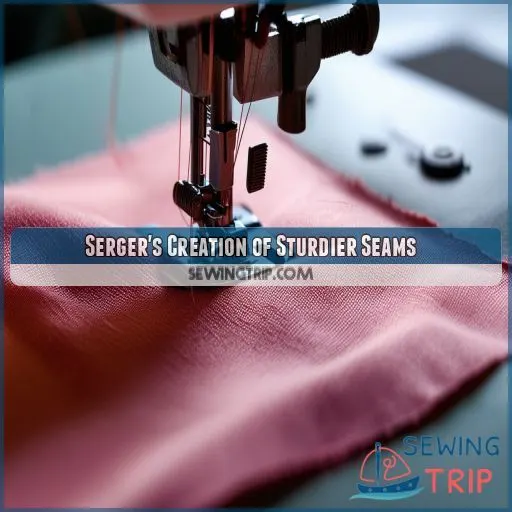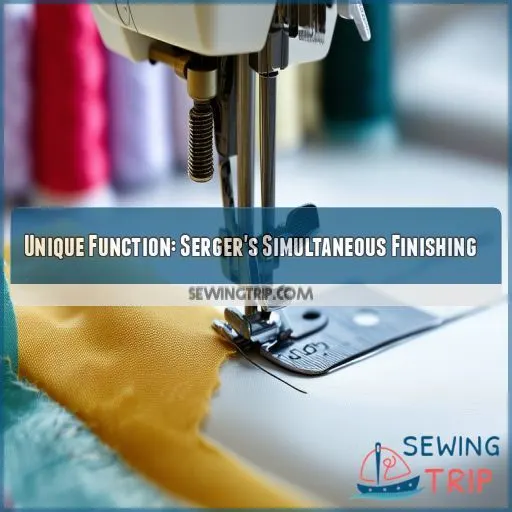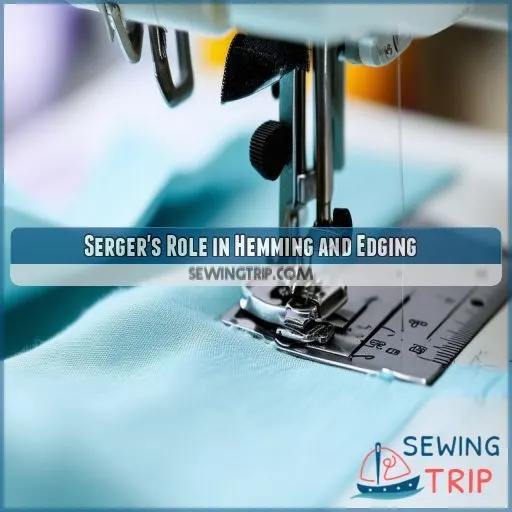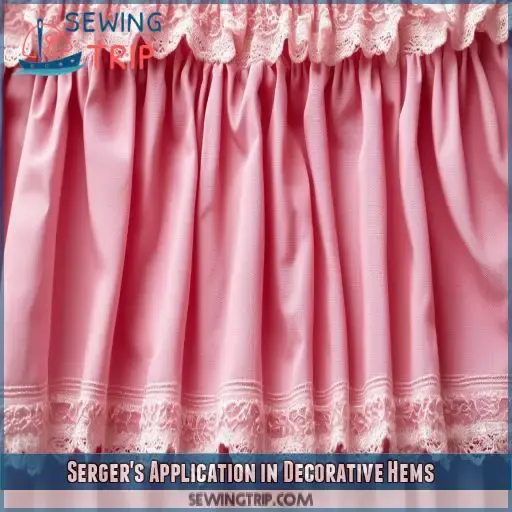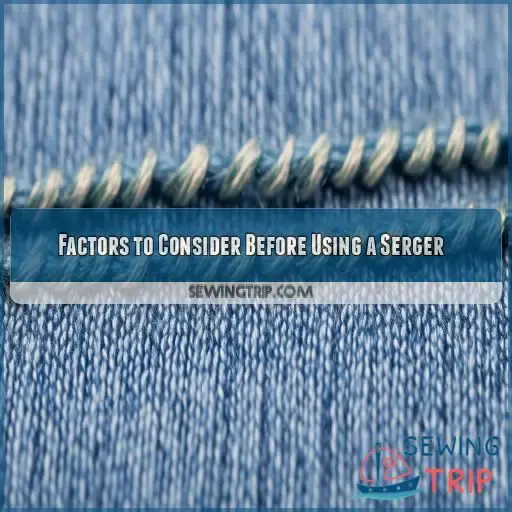This site is supported by our readers. We may earn a commission, at no cost to you, if you purchase through links.

From creating professional-grade seams to handling stretchy fabrics with ease, sergers expand your crafting potential. They excel at finishing edges, preventing fraying, and producing decorative stitches.
In this article, we’ll reveal the key differences between sergers and sewing machines, helping you understand when and why you might need this innovative tool.
Table Of Contents
- Key Takeaways
- What Does a Serger Do That a Sewing Machine Can’t?
- Serger’s Multiple Thread Capabilities
- Serger’s Speed and Control
- Serger’s Compatibility With Various Fabrics
- Serger’s Adjustable Cutting Width
- Serger’s Creation of Sturdier Seams
- Unique Function: Serger’s Simultaneous Finishing
- Serger’s Role in Hemming and Edging
- Serger’s Efficiency in Preventing Fraying
- Serger’s Application in Decorative Hems
- Factors to Consider Before Using a Serger
- Frequently Asked Questions (FAQs)
- Conclusion
Key Takeaways
- Sergers are the multitasking ninjas of the sewing world – they trim, stitch, and finish edges all in one go. Talk about efficiency!
- These machines are a godsend for stretchy fabrics. No more wavy seams or popped stitches when you’re working on that yoga pants project.
- Want to add some pizzazz to your creations? Sergers can whip up decorative edges faster than you can say "rolled hem."
- While sergers are awesome, they’re not jacks-of-all-trades. You’ll still need your trusty sewing machine for zippers and buttonholes. It’s like peanut butter and jelly – they’re better together!
What Does a Serger Do That a Sewing Machine Can’t?
A serger does several things that a sewing machine can’t. It simultaneously trims fabric edges and creates overlock stitches, preventing fraying and adding durability. You’ll find it handles multiple threads (2-5) at once, creating professional-looking seams and finishes.
It’s a speed demon, sewing twice as fast as regular machines. Sergers excel with stretchy fabrics, creating flexible seams that won’t pop. They’re masters of rolled hems and can adjust cutting width for various projects.
While sewing machines are versatile, sergers specialize in creating strong, neat edges and seams. If you’re curious about how a serger can elevate your sewing game, there’s more to explore.
Serger’s Multiple Thread Capabilities
You’ve probably wondered what distinguishes a serger from your trusty sewing machine. Well, it’s all about the threads! A serger’s multi-thread capabilities are a game-changer in the sewing world. While your regular machine typically uses just one thread, a serger can handle anywhere from two to five threads simultaneously.
This multi-thread efficiency creates an overlock stitch that’s not only durable but also incredibly versatile. You’ll find that the serger’s threads work together like a well-oiled machine, each playing a vital role in creating sturdy seams.
The differential feed guarantees smooth fabric handling, preventing puckering or stretching. Whether you’re working with delicate chiffon or sturdy denim, the serger’s thread system adapts beautifully.
Plus, with options like 2-4 thread and 3-4 thread configurations, you can customize your stitching to your project’s specific needs. It’s like having a Swiss Army knife for your fabric!
Serger’s Speed and Control
Building on the multi-threaded capabilities, let’s delve into a serger’s speed and control. You’ll find that these machines are true workhorses, sewing twice as fast as regular sewing machines. This efficiency is due to their automated thread flow and reduced manual labor.
With a serger, you’ll experience:
- Lightning-fast stitching that’ll make your projects soar
- Smooth, automated thread flow for effortless sewing
- Precise control over your sewing speed
- Double-needled topstitching for professional finishes
- Noticeably reduced production time for garments
The controllable speed allows you to tackle tricky areas with assurance, while the automated features let you glide through straightforward sections. You’ll appreciate the balance of power and precision as you work on various projects. The serger’s ability to create clean, professional edges at high speeds is truly transformative. Whether you’re a hobbyist or a professional, this combination of speed and control will revolutionize your sewing experience.
Serger’s Compatibility With Various Fabrics
You’ll be amazed at how versatile a serger can be in handling different fabrics. Unlike traditional sewing machines, sergers excel at working with knit fabrics, creating stretchy seams that move with the material. But that’s not all – they’re also masters at handling tricky fabrics like lace, vinyl, and even sequins.
The serger’s unique stitch formation allows it to create clean, professional-looking hems on delicate materials without puckering or distorting the fabric. When working with slippery fabrics, the serger’s differential feed can be adjusted to prevent stretching or bunching.
For heavier materials like denim or canvas, a serger can power through multiple layers with ease. It’s like having a Swiss Army knife for fabric – no matter what material you throw at it, your serger’s got you covered. From silky chiffons to bulky sweater knits, this machine trims, finishes, and secures in one swift motion.
Serger’s Adjustable Cutting Width
As you’ve seen, sergers excel at handling various fabrics. Now, let’s explore another game-changing feature: adjustable cutting width. This nifty capability allows you to fine-tune your serging process with precision.
Here’s what adjustable cutting width brings to the table:
- Customizable seam allowances for different projects
- Ability to create rolled hems with varying widths
- Flexibility in overcasting edges, from delicate to bulky fabrics
You’ll find this feature particularly useful when working with stretch fabrics or creating durable edges. By adjusting the cutting width, you can control how much fabric is trimmed as you serge. This means you can easily switch between wide, sturdy seams and narrow, delicate finishes.
The differential feed works in tandem with adjustable cutting width, ensuring smooth fabric flow and preventing puckering or stretching. Whether you’re crafting a rolled hem or overcasting raw edges, this feature gives you the power to achieve professional-looking results every time.
Serger’s Creation of Sturdier Seams
Now that you’ve mastered adjustable cutting width, let’s delve into how sergers create sturdier seams. You’ll find that serger seam durability is unparalleled. By using multiple threads and specialized stitches, sergers produce seams that can withstand more wear and tear than traditional sewing machines.
Thread tension adjustment plays a key role in achieving this strength. You’ll need to fine-tune the tension for each thread to create the best stitch formation. Needle selection impact can’t be overlooked either – choosing the right needle for your fabric thickness is key.
Stitch length optimization further enhances seam durability. Shorter stitches generally create stronger seams, but you’ll want to balance this with fabric thickness considerations. For example, thicker fabrics may require longer stitches to prevent puckering.
From basic seams to rolled hems, sergers excel at creating sturdy finishes. You’ll notice the difference in durability, especially when working with knits or stretchy fabrics.
Unique Function: Serger’s Simultaneous Finishing
You’re in for a treat with a serger‘s unique simultaneous finishing function. Unlike a regular sewing machine, a serger (also known as an overlocker) performs multiple tasks in one go. It’s like having a Swiss Army knife for your fabric!
As you guide your material through, the serger trims the edges, creates a seam, and finishes the raw edge – all in one swift motion. This triple threat capability is what sets it apart from its traditional counterpart.
You’ll notice the professional-looking results immediately, with neat, tidy seams that resist fraying. It’s particularly handy for knit fabrics, which can be tricky to finish on a standard machine.
With a serger, you’re not just sewing; you’re creating garments that look store-bought. The time you’ll save is just icing on the cake!
Serger’s Role in Hemming and Edging
Concerning hemming and edging, a serger truly excels. You’ll discover that it’s not merely about speed; it’s about precision and versatility as well. Unlike a regular sewing machine, a serger can create professional-looking hems on a variety of fabrics in one swift motion. It’s like having a personal tailor at your fingertips!
You’ll love how a serger handles stretchy materials, giving you neat, flexible hems that move with the fabric. It’s a game-changer for knits and activewear. But don’t think it’s limited to just stretchy stuff – sergers are equally adept at creating crisp edges on woven fabrics.
While there’s a learning curve and maintenance costs to factor in, many sewists find the serger’s value for money in hemming and edging alone justifies the investment. It’s not about replacing your sewing machine, but complementing it for specific tasks.
Serger’s Efficiency in Preventing Fraying
In terms of fray prevention, your serger is a transformative tool. Unlike typical sewing machines, sergers excel at creating sturdy edges that resist unraveling. The overlock stitch, a signature feature of serger functionality, encloses raw fabric edges in thread, effectively sealing them off. This technique is particularly valuable for:
- Stretchy fabrics that tend to fray easily
- Delicate materials prone to unraveling
- High-stress seams that need extra reinforcement
You’ll find that the serger’s ability to create rolled edges adds another layer of fray protection. By tightly wrapping the fabric’s edge in thread, you’re not only completing the seam but also fortifying it against wear and tear. This efficiency is unmatched by standard sewing machines, making sergers indispensable for projects requiring long-lasting, professional-looking results. Remember, a well-serged edge isn’t just about neatness—it’s about extending the life of your garments and ensuring they endure the test of time.
Serger’s Application in Decorative Hems
When it pertains to decorative hems, your serger has some tricks hidden away. You’ll notice it’s a whiz at crafting eye-catching edges that will make your projects stand out. Let’s explore the realm of serger decorative hems and see what you can attain.
| Technique | Description | Best for |
|---|---|---|
| Rolled Hems | Tiny, tightly rolled edge | Delicate fabrics, scarves |
| Wave Stitch | Wavy pattern along edge | Casual wear, home decor |
| Picot Edge | Delicate scalloped edge | Lingerie, baby clothes |
With serger decorative stitches, you’re not just finishing edges – you’re adding flair. Try serger embellishments like gathering or ruching for extra texture. For a professional touch, experiment with serger decorative edging on necklines or sleeve hems. You’ll be amazed at how these techniques can transform a simple garment into a designer piece. Remember, practice makes perfect, so don’t be afraid to experiment with different thread colors and tensions.
Factors to Consider Before Using a Serger
Before investing in a serger, you’ll need to weigh the cost against its potential benefits for your sewing projects. You should also consider the types of fabrics you frequently work with and be prepared for a learning curve as you master this specialized machine’s techniques.
Cost Vs. Benefit Analysis
While decorative hems are alluring, let’s crunch some numbers. When comparing a serger vs. sewing machine, consider the cost vs. quality trade-off. Sergers’ price range varies widely, but durability and brand reputation matter. Assess your needs carefully—a higher upfront investment might pay off in long-term efficiency and versatility.
Fabric Type Compatibility
After weighing costs, consider fabric compatibility. Your serger shines with elastic fabrics and delicate materials. It handles tricky fabrics like chiffon or spandex with ease, offering specific stitches for each. You’ll achieve professional, decorative finishes on knits that a regular sewing machine can’t match. It’s a game-changer for diverse projects.
Learning Curve Assessment
You’ll face a learning curve with a serger. Mastering thread tension, bobbin loading, and stitch length takes practice. Tension adjustment can be tricky, and you’ll need to familiarize yourself with different thread types. Don’t get discouraged; with patience, you’ll soon be creating professional-looking finishes like a pro!
Frequently Asked Questions (FAQs)
Why use a serger instead of a sewing machine?
You’ll use a serger for faster, neater seams on stretchy fabrics. It trims and finishes edges simultaneously, preventing fraying. You’ll get professional-looking results, especially on knits, and save time on finishing touches for your garments.
What can a serger do that a sewing machine cannot?
You’ve heard the buzz, but what’s the real deal? A serger can simultaneously trim fabric edges and create overlocking stitches, preventing fraying. It excels with stretchy fabrics and creates professional-looking seams faster than traditional sewing machines.
Can a serger do everything a sewing machine can?
No, a serger can’t do everything a sewing machine can. You’ll still need a regular machine for tasks like zippers, buttonholes, and topstitching. Sergers excel at finishing edges and creating stretchy seams, but they’re more specialized.
What is the purpose of a serger?
Threading through your sewing challenges, a serger’s purpose is to trim and finish fabric edges simultaneously. You’ll create professional-looking seams, prevent fraying, and handle stretchy fabrics with ease. It’s your go-to for speedy, polished garment construction.
Can a serger sew buttonholes or attach zippers?
No, you can’t use a serger for buttonholes or zippers. It’s designed for finishing edges and seams, not precision tasks. You’ll need a regular sewing machine for those jobs. Sergers complement but don’t replace standard machines.
How noisy are serger machines compared to sewing machines?
While you might worry about noise, sergers are generally louder than sewing machines. They operate at higher speeds and use multiple threads, creating a distinctive sound. You’ll notice increased volume, but it’s not deafening. Ear protection isn’t typically necessary.
Is it possible to use regular thread in a serger?
You can’t use regular thread in a serger. It requires special serger thread that’s thinner and stronger. Using regular thread can damage your machine and result in poor-quality seams. Stick to serger-specific threads for best results.
Can sergers handle heavy-duty fabrics like leather or denim?
When the going gets tough, sergers get going. They can indeed handle heavy fabrics like leather and denim. You’ll need the right needles and threads, but sergers can power through thick materials, creating strong, professional-looking seams.
How often does a serger machine require maintenance?
You’ll need to maintain your serger regularly. Clean it after every project, oil it monthly, and have it professionally serviced annually. Frequent use may require more attention. Don’t forget to change needles and check tension often.
Conclusion
Like a skilled artisan wielding a specialized tool, you now understand what a serger can do that a sewing machine can’t. From its multiple thread capabilities to its speed and fabric versatility, a serger offers unique advantages.
It creates sturdier seams, prevents fraying, and excels in decorative finishes.
Before investing, consider your needs, budget, and willingness to learn.
Whether you’re tackling stretchy fabrics or aiming for professional-grade finishes, a serger can be a valuable addition to your sewing arsenal, expanding your creative possibilities.

